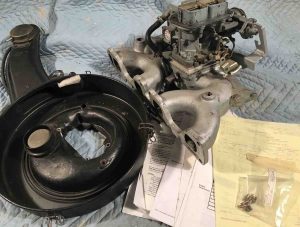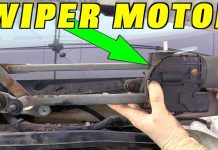One of the great virtues of mechanical cars is that when something goes wrong, it is usually possible to fix it. Even if you haven’t got exactly the right part, you can often make it work.
Even if it wasn’t original to the car – or even that make of car.
One of the great detractions of electronic cars is that when something goes wrong, you often have to replace it. And with parts specific to that car.
You don’t, for example, repair the components that make up electronic fuel injection; the injectors and sensors, etc. When they stop working, you replace them with new parts.
But what if you haven’t got them? What if you can’t get them?
You might be able to retro-fit different parts.
Much depends on how electronic your car – or truck – is.
And how adaptable.
My ’02 Nissan isn’t very electronic and so potentially very adaptable. It does have electronic fuel injection, which means it has an electronic brain (computer) to control its operation. But the rest of the truck is entirely mechanical, including its manual transmission – which is entirely controlled by me. Many vehicles from that era are similar – and this is really good news, if you own one, in that they are . . . adaptable vehicles.
For instance, it is possible to de-electronicize a truck like my ’02 Nissan pick-up because it does not need electronics to run, excepting for the fuel system. But that can be replaced – with something that can be fixed. In the case of my truck, it is possible to retrofit an entirely mechanical fuel delivery system in place of the factory fuel injection system. No more injectors, no more sensors – and no more computers. Instead of all of that – including all of the wires that go with that – just two major mechanical parts, one of which will likely never (as in ever) need to be fixed or even fiddled with in any way and the other a simple device that will need occasional fiddling but which is easy to fix, essentially indefinitely.
These two parts are an intake manifold and a carburetor.
The intake is a piece of cast aluminum that bolts up to the engine and the carburetor is a piece of cast aluminum that bolts on top of it. If both physically fit, they will probably work – or can be made to work.
The intake has no – as in zero – moving parts. Its only role is to conduit the air/fuel mix from the carburetor to the engine’s intake ports. The carb has some moving parts but zero electronic parts. The parts that move can be seen, so it is easy to see their workings and get your hands on them if they aren’t. They are basic fuel-delivery devices that date back more than 120 years to the dawn of the automobile age, when cars were simple – mechanical – devices designed such that anyone could fix whatever what went wrong.
Going back to that ethos might not only be good – in the sense of less dependence upon inscrutable electronics that few understand and which generally cannot be fixed – but also necessary.
Just ask the Cubans.
They know all about adaptability, having been practicing it for the past 60-plus years. Not having been able to get new parts – as well as new cars – they have kept the cars they have going for that long. Which they have been able to do because those cars are also mechanical cars and so adaptable cars. You can install an engine from a ’55 Chevy in a ’62 Plymouth – and use a Studebaker carburetor on either. It just takes some fiddling – and the Cubans have become experts at this.
We may need to emulate their example.
The past couple of years have been an object lesson in supply chain dependence. There is also the danger of newness – in that everything new (as far as what makes cars go) car is electronic and designed to be disposable. This works fine when new parts are available and when there are people who know how to get electronic components to work – including dealers with the proprietary equipment you and I do not have that is often necessary to get them to work.
It works not-so-fine when the electronic parts are on back order, indefinitely. Or discontinued. Or there’s no dealer available to “program” them.
Mechanical devices work just fine without any of that – and assuming you have a few basic tools, you can keep a carbureted fuel delivery system working for decades.
This, of course, bucks the trend of retrofitting older mechanical cars with systems from newer electronic cars, such as electronic fuel injection, for instance. But – say what you will about the “easy starting,” “better drivability” and “low maintenance” of electronic fuel injection – and all of that is perfectly true – what cannot be said about these electronic systems is that they are SHTF fixable and decades-durable.
For that scene – and we may be facing it, soon – it is hard to beat adaptability.
Just ask the Cubans!
. . .
If you like what you’ve found here please consider supporting EPautos.
We depend on you to keep the wheels turning!
Our donate button is here.
If you prefer not to use PayPal, our mailing address is:
EPautos
721 Hummingbird Lane SE
Copper Hill, VA 24079
PS: Get an EPautos magnet or sticker or coaster in return for a $20 or more one-time donation or a $10 or more monthly recurring donation. (Please be sure to tell us you want a magnet or sticker or coaster – and also, provide an address, so we know where to mail the thing!)
My eBook about car buying (new and used) is also available for your favorite price – free! Click here. If that fails, email me at EPeters952@yahoo.com and I will send you a copy directly!













Between the government and the auto makers, they have done a great job or making sure no third party replacement electronics industry was ever developed. It’s a business that should have been, starting in the late 1970’s. Up until electronics came to be in autos, all kinds of third party upgrades and replacements were always quick to market after the became mainstream. Sometimes the third party add-ons BECAME the standard for the automakers later on.
If anything electronics should have been the EASIEST thing to standardize across an automakers lineup. Why does it need to be that different for every stinking model (or even within a model)? It’s not that different controlling how a computer controls rolling up an electric window from vehicle to vehicle.
The youtuber “car wizard” (hoovie’s mechanic) is noting pretty often lately, how its getting tougher to find any parts (not just electronics).
1969 SE-124 Chevelle Converted to Steam by Bill Besler
https://www.youtube.com/watch?v=COP9iGRUQV4
When they ban gas and diesel powered ice…get one of these…
Coal Fired Steam Cycle – Unique Steam Powered Bike
A work of art….all mechanical, no electronics….easy to repair….last 100 years….
Burns far less coal per mile then an EV…..
https://www.youtube.com/watch?v=6hUMXWNcwx4
Steam bike
https://www.youtube.com/watch?v=03Kb5r7MHXE
Speaking of adaptable vehicles, here is a well-informed rant complaining of the lack of adaptability of motorcycles:
‘The cheapest car has adjustable seats and steering columns, and has for ages. Bicycles come in as many as eight frame sizes per model, plus they have another four or five inches of adjustability built into the seat post. But if you don’t fit a motorcycle, you either carve foam from the seat or lower the suspension. What’s going on?
‘I expected former Yamaha designer Michael Uhlarik to give me a straightforward answer as to why towering seat heights on modern motorcycles are unavoidable. His answer shocked me. “It’s nothing more than engineering dogma,” said Uhlarik. “There is no reason.” Much of it comes down to generous suspension travel, he explained, which is prioritized over ease of use for the rider.
‘The seat height conundrum—as well as the ballooning weight of contemporary motorcycles—is a byproduct of progress. As motorcycles become more powerful, frames become stronger and heavier. Tires get larger. Fuel capacity more generous. Designers and engineers have done an astounding job of improving motorcycles—but they’ve done so at the expense of the very riders these improvements have benefited.
‘Motorcycles that don’t fit average-sized riders are perhaps the most glaring oversight in all of industrial design. It’s hard not to imagine that the first manufacturer that acknowledges that humans come in different sizes will have a worthwhile leg up in the marketplace.’
https://www.advrider.com/high-and-mighty/
I’m 6′-01″ … but the seat height on my trail-oriented Suzuki DR650 is awkwardly, uncomfortably high. So I’m going to replace it soon. Ergonomics, bitches!
Hi Jim,
I will “amen” this. I’m 6ft 3 and even for me, many new full-size bikes are slightly awkward to “walk” on account of that. I consider this dangerous, too, as it is much easier for the weight of these things to get away from you and drop the bike. Then you will need help getting the thing off of you! The ergos of all my ’70s-’80s era bikes are much better. There is some good news as regards new bikes though. A number of bikes that emulate the “standard” UJMs and Brit bikes of the ’70s and ’80s are now available, including the Kaw Z1 – which is so much like my KZ900 it’s hard to tell them apart from 20 yards out!
I agree with you and Jim about the motorcycle seat height problem. IMO part of the blame was forcing manuf. to add catalytic converts to DOT bikes now. Where do you put them? Most manuf. have put them under the engine, raising the whole setup, some above or in the front swingarm area, again raising the whole setup.
For dirtbikes, or should I better define, racing dirtbikes, no cat needed because they aren’t DOT, however the consumer wants better suspension travel, as Jim mentioned, but also increased engine ground clearance. No other way to go than up. This presents a huge problem for beginners and why most manuf. now make entry level ‘trail bikes’ for lower seat heights.
One new bike, the Harley Pan America, can now come with ‘height adjustable’ suspension, and it works well for this short guy, 5-7, 29″ inseam. So if you can get over the e-stuff, it raises itself for off-road work, and lowers itself when you come to a stop. Pretty cool.
And you guys may laugh or call me crazy, but on my racing dirtbikes that I can’t touch the ground now, I add a ‘taller’ seat. What? Why? Because it makes you fit the bike better for aggressive riding, standing/sitting, etc.. Touching the ground is not part of the equation during a race. Do I get stuck sometimes and fall over because I can’t touch the ground, yes, but my fault, your not supposed to stop or go slow over rock/boulder sections.
My wife recently got a ktm 390 and is a beginner, and it’s too tall for her. There are ways to lower it, which I am doing now. But if/when she becomes an intermediate, she’s going to want it back to taller for more ground clearance. We’ll see.
My ’02 Nissan
An AMURican auto tester is driving a 20 year old JAPANeezer truck?
Shouldn’t you be driving a modern American hot rod?
You get plenty of vehicles to test, Mr. Peters.
Some of them must be good vehicles you’d like to own
Just keep the next good one, hide it, and tell them it was stolen.
My friend Marvin will do it for you, for a fee.
You can contact him at:
Marvin “I didn’t do it” Washington
Suite 34
Cellblock B
Jackson State Prison
Jackson, Michigan 49201
Note: Marvin will be getting released in six months. Even sooner if you write to him, tell him yiu want to purchase his “car relocation services”, and enclose a sharp hacksaw blade in your envelope.
I refrain from commenting when I have been drinking heavily. You should do the same.
I do not drink, or use street drugs,
but I do have a sense of humor.
And you don’t
Hi Richard,
I stick with vehicles that work for me. And which I know to be good vehicles. The Nissan “hardbody” and Frontiers pre-2004 being an example. Toyota Tacos are superb, too. I’d have one of the latter if I could afford one of the latter. I also like Chevy half-ton trucks made before circa 2000; also the Tahoe. But I do not need a full-size truck or SUV.
There are a handful of new cars that interest me, among them the Miata and the Challenger. The Miata is in my opinion the finest mass-market sports car ever made. The Challenger is perhaps the ultimate expression of the muscle car concept. But I content myself with the Great Pumpkin, my ’76 Trans-Am. It is paid-for and costs me almost nothing to keep – unlike anything new, courtesy of the parasites styled “government.”
Many of those Cuban cars have Soviet diesels under the hood.
Ironically enough right? Diesel baddddddd!
I would make the same argument for the virtues of a pre cat wood stove. Simple, durable, reliable, no moving parts, can be welded if necessary. You can dry clothes, boil water, cook and heat your home on one appliance which runs on trees which are near at hand. A wood stove repairman would not make anything like the money an HVAC guy reliably brings in every year.
The biggest fly in your ointment, is ethanol in gas. I also prefer the simple reliable and economical carburetor on my cars. Unfortunately, I have a modest collection and many of my rigs dont run for a year at a stretch, longer if they are an ongoing project. Expensive gas is the only workaround I have found- preferably 100LL avgas. Of course, for a daily driver, that ethanol will stay fresh and not be an issue.
One hurdle you may have to overcome to convert eft to carbs is spark. If you don’t have a distributor it might be quite a challenge to get the conversion to work. I stand to be corrected.
Hi Mark,
Yup; I ought to have mentioned that. In the case of my truck, it’s not an issue because it has a distributor. Not coil-on-plug.
Shouldn’t be too hard to install an aftermarket EFI. Sure you’re back to electronics vs mechanical, but you have a whole lot more access to the module, and in some cases can flash open firmware on the thing.
https://rusefi.com is the first hit on searching for “open source engine efi.” The firmware is avilable on GitHub.
You ain’t getting me to go back to carbs, bro! Not happening! I will take the rickshaw first.
I love your work, but promoting the practice of the black magics of carbs is not for the betterment of mankind. I guess you want me to start throwing chicken bones again for secondary jet selection too!!!
Hi Local,
Horses for courses!
Yes, carbs require more fiddling. But they have the virtue of being “fiddle-able.” EFI isn’t. The latter can be “tuned,” but that is different. When it stops working, it stops working. Typically, getting it working again means buying a replacement electronic component.
The carb set up for my old truck is a simple two barrel that almost anyone could tune, given a little patience and basic hand tools. Then you’re good – essentially forever.
The four barrel that feeds my Trans Am’s V8 is the same one it left the factory with, almost 50 years ago. Even if I had to replace the whole thing, a brand-new one is about $500. And it takes 10 minutes to replace.
‘ Yes, carbs require more fiddling ‘
Absolutely! Man up, grab that screwdriver and get to it! By ‘79 GM had removed the power valve in the quadrajet, made for a cold / warmup bog that was not fixable with staying with stock carb settings. The vacuum controlled metering rods not up to the task. My 79 Pontiac still had the hot air choke so I hacked the hot air tube and soldered on a cold air bleed tube with a little valve, after several mornings got it just right. For the six weeks of Northwest Summer, turn the valve in a bit for that just right warm up. Reason for the hack, if you dialed up the tension on the choke coil it would apply choke to a warm engine on a cold day restart, not good.
Back when I used to work on my own cars (e.g., ’65 mustang, junk edition), I used to dream about the day when many/most parts would become universal. because then it’d be so much easier to keep things in good repair and on the road. that would extend the maximum possible life of any such cars.
LOL
Little did I know that everything was specifically being made to head the exact opposite direction from that naive dream!
These same people shrieking about “saving the planet” are quite purposefully making every damn thing disposable by design.
Notice that none of them are crying about what is ending up in landfills, except maybe plastic straws and water bottles. no concern about the umpteen million computer peripherals, monitors, and now entire cars which will apparently become younger and younger residents of the landfill.
I’m so sick of hearing their preposterous insanity! FFS
Or, as is the case with my ’97 Tacoma, being like your Nissan, having electronic fuel injection, and nothing else electronic, a mechanical system may run for decades with little to no repair needed. All the work I’ve done to it in the 20 years I’ve owned it would be considered maintenance. Spark plugs and wires, belts, hoses, etc. Still runs like a top.
Electronic parts have a relatively short life span when compared to mechanical parts.
I recently retired my ’61 880 David Brown diesel tractor, because the transmission was leaking a pint of oil per day, whether running or not. With a 5 gallon capacity, at today’s oil prices, it meant It would cost me 60-70+ dollars to START it. Other lesser problems pre-empted me from investing in repair, that and the LACK of availability of parts for a 60 year old tractor, who’s maker has not been in business for 50 years. But, if I charged the battery, and filled the transmission, and put clean fuel in it, I guarantee it would start right up and do a days work. I bought it for $1800 thirty years ago. I think I got my money’s worth.
I seen a YouTube video where a guy fitted a lawnmower carburetor onto a V8 engine via a 3D printed adapter. It worked and drove well afterwards. This shows that if you’re handy you can probably make anything work. It just takes a little effort and research.
To give you an idea how stupid some new stuff is a Chevy truck with direct injection went into my local garage the other day. The fuel pump is under the intake and leaked gas into the oil for a long enough time to dilute the oil enough to take out the motor. Sounds like another reason to avoid new cars. The oil smelled like like gasoline.
‘One of the great detractions of electronic cars is that when something goes wrong, you often have to replace it. And with parts specific to that car.’ — eric
Here is a longer-form version of Eric’s assertion, from the Dieseltoys site which someone helpfully posted yesterday:
‘In order to have all the components needed for a diesel conversion, we have to buy complete, low-mileage vehicles and strip them of all of their usable parts. We do this for two reasons. First, the engine, transmission, all wiring, accessories, instrumentation, computers all need to be diesel-specific and from the same vehicle. All of these components need to match.
‘Due to the technical requirements of performing an engine conversion, we need to buy year-specific components that are as similar as possible to your conversion vehicle. This way we can ensure vehicle compatibility as much as possible.’
https://www.dieseltoys.com/copy-of-about
This did not use to be so. The Nissan Frontier compact trucks used as an example by Eric shared many mechanical components among the pre-1998 Hardbody model years and the first-gen 1998-2004 Frontiers. Year-matching was no big deal. Now it can be a hardball show-stopper.
Jim,
In the 65-66 model years, Chevy pickup trucks were IDENTICAL. In that era, there were several years of identical parts used among all makers. Even body parts and windows. Which is why salvage yards used to be a booming business. And why durability was not such an urgent issue.
I’m daydreaming of buying a Taco or 4runner dirt cheap with an engine and trans on the way out and shipping it to them to give me something unique, but I digress
Shame it’s gotta be year specific though, why older is better in general